The ideal LED ring light for scientific photography offers adjustable color temperatures (3500K-7500K), high CRI (90+), and multi-zone illumination to eliminate shadows. Look for models with 96-144 LEDs providing up to 35,000 LUX and independent brightness controls. You’ll want minimal heat output for live specimens, USB or universal voltage options, and proper diffusion capabilities. These features guarantee accurate specimen documentation while revealing details invisible to the naked eye.
Understanding LED Ring Light Technology for Scientific Imaging
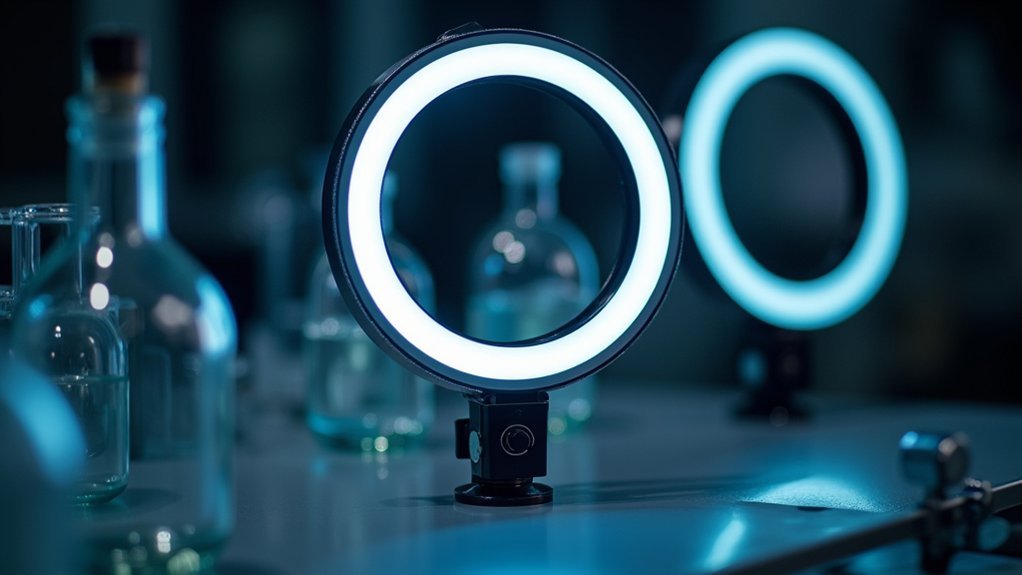
While traditional lighting solutions often fall short in scientific applications, LED ring lights have revolutionized scientific photography with their specialized features.
You’ll notice their minimal heat production makes them ideal for live specimen observation without causing thermal stress—crucial for biological studies.
LED ring lights deliver even illumination across your entire viewing field, eliminating shadows that might obscure important details.
With adjustable color temperatures (3500K-7500K), you can enhance visibility and analyze intricate structures with precision.
The high CRI ratings above 90 guarantee accurate color representation for your scientific documentation.
Many models feature independently controlled LED zones, allowing you to tailor brightness for specimens at various distances.
This customization capability, combined with consistent illumination, dramatically improves image quality in microscopy and scientific photography.
Top LED Ring Lights for Microscopy Applications
When choosing LED ring lights for microscopy, you’ll find models with 96-144 LEDs offering powerful illumination up to 35,000 LUX with adjustable color temperatures from 3500K to 7500K.
Advanced systems like the Microscope LED Ring Light provide independent control over four lighting zones, allowing you to eliminate shadows and highlight specific areas of your specimen.
These LED illuminators produce minimal heat during operation, making them safe for extended observation of living specimens without risking thermal damage.
LED Illumination Fundamentals
Because LED technology has revolutionized scientific imaging, understanding the core principles behind ring lights is essential for microscopy success.
Quality LED ring lights feature at least 96 individual diodes that create even lighting across your entire field of view, eliminating shadows that can obscure critical details.
You’ll want to look for models delivering 30,000-35,000 LUX illuminance for maximum specimen visualization. The best systems offer adjustable color temperatures (3500K-7500K), allowing you to enhance different specimen characteristics—warmer tones for color contrast and cooler tones for structural analysis.
Many advanced options include independently controlled LED zones for fine-tuned brightness across your viewing field.
Most USB-powered units operate on 5V for setup flexibility, while others support universal voltage (110-240V) for international use. Their minimal heat output makes them ideal for live specimen observation.
Multi-Zone Lighting Technology
Modern multi-zone lighting has transformed microscopy by giving scientists unprecedented control over their illumination environment.
With independent LED segment control, you’ll eliminate shadows and optimize lighting conditions for even the most challenging specimens.
Multi-zone lighting technology offers significant advantages:
- Enhanced visibility with models featuring 144+ RGB LEDs that provide superior brightness and color accuracy when examining intricate structures.
- Customizable lighting conditions through adjustable brightness controls across multiple zones, allowing you to fine-tune intensity for various sample types and distances.
- Improved contrast with color temperature ranges from 3500K to 7500K, highlighting surface textures and imperfections critical for quality assurance.
Whether conducting biological studies or material analysis, independently controlled lighting zones reveal details that would otherwise remain hidden, elevating your scientific photography to new levels of precision.
Heat-Free Specimen Protection
Unlike traditional halogen illumination systems that generate excessive heat, LED ring lights provide essential thermal protection for your sensitive specimens.
With models like the Upwtkim 96 LED Ring Light producing minimal heat while delivering up to 35,000 LUX of brightness, you’ll achieve excellent visibility without risking thermal damage to live samples.
The heat-free specimen protection offered by LED technology guarantees you can conduct extended observation sessions without compromising sample integrity.
Adjustable color temperatures from 3500K to 7500K enhance specimen detail visibility without introducing unwanted warmth.
You’ll also benefit from LED’s longer lifespan compared to halogen alternatives, guaranteeing consistent performance throughout your research projects.
The independent zone control available in many LED ring lights further enhances your ability to maintain perfect illumination without shadows or hot spots.
Essential Features for Specimen Photography Illumination
For specimen photography, you’ll need LED ring lights offering consistent uniform light distribution to eliminate shadows and reveal fine details.
Your photography setup should include color temperature controls that adjust between warm and cool tones, helping you highlight specific specimen features and enhance contrast.
Don’t overlook the importance of proper diffusion and reflection capabilities, which soften harsh light and reduce unwanted glare on reflective specimen surfaces.
Uniform Light Distribution
Three critical aspects define uniform light distribution in LED ring lights for scientific photography. When documenting specimens, you’ll need even illumination to reveal fine details without distracting shadows or highlights that can compromise accuracy.
- Radial illumination – Ring lights naturally distribute light in a circular pattern around your subject, minimizing directional shadows that might obscure critical features.
- Multi-zone control – Advanced models offer independently controlled lighting segments, allowing you to customize angles and eliminate unwanted shadows in complex specimens.
- Brightness adjustment – Fine-tuning intensity guarantees consistent lighting across different working distances, maintaining even illumination regardless of your specimen’s size.
With proper uniform lighting, you’ll capture specimens with scientific accuracy, preserving subtle textures and guaranteeing all details remain clearly visible for analysis and documentation.
Color Temperature Control
When capturing scientific specimens with precision, color temperature control becomes a fundamental feature in LED ring lights. You’ll find adjustable settings typically ranging from 3500K to 7500K, enabling you to optimize light quality for different specimen types.
| Temperature | Best For | Light Quality | Application |
|---|---|---|---|
| 3500K (Warm) | Biological specimens | Enhanced color contrast | Tissue samples, insects |
| 5000K (Neutral) | General photography | Balanced illumination | Documentation, teaching |
| 6500K (Cool) | Structural details | Sharp definition | Crystalline structures |
| 7500K (Very Cool) | Intricate analysis | High detail resolution | Microscopic features |
Fine-tuning your color temperature guarantees shadow-free illumination across the viewing field, contributing considerably to accurate color representation and detail preservation. High-quality LED rings offer granular adjustments so you can tailor lighting precisely to your scientific needs.
Diffusion and Reflection
While color temperature adjustment helps capture accurate specimen colors, the way light interacts with your subjects determines overall image quality.
Effective diffusion in LED ring lights transforms harsh directional lighting into soft, even illumination that reveals critical specimen details without distracting shadows.
When selecting your scientific photography lighting setup, prioritize:
- Opaque diffusion panels that soften light and minimize glare, preventing bright reflections that might obscure minute specimen features.
- Multiple independently controlled LED zones for reducing shadows across your entire field of view, guaranteeing uniform illumination even of complex three-dimensional specimens.
- Ring lights with high-quality diffused light mechanisms that distribute illumination evenly, eliminating harsh contrasts that can interfere with accurate observation and documentation.
These diffusion features work alongside high CRI values to guarantee your scientific imagery captures specimens with laboratory-grade precision.
Color Temperature and Its Impact on Scientific Accuracy
Although often overlooked, color temperature plays a critical role in scientific photography where accuracy is paramount. When you’re capturing specimens or experimental results, the Kelvin rating of your lighting solution directly affects color representation and detail visibility.
For most scientific applications, aim for around 6500K, which mimics natural daylight and guarantees consistent color accuracy across specimens. This is especially important when documenting biological structures where specific wavelengths highlight different features.
Your LED ring light should have a high Color Rendering Index (CRI) of 90+ to prevent color distortion. Look for models with adjustable color temperature settings (3000K-7500K) to maintain uniformity across imaging sessions.
Without this control, you risk misinterpreting critical data, as warm tones (lower K) versus cool illumination (higher K) can dramatically alter how specimens appear.
Comparing Adjustable vs. Fixed Intensity Ring Lights
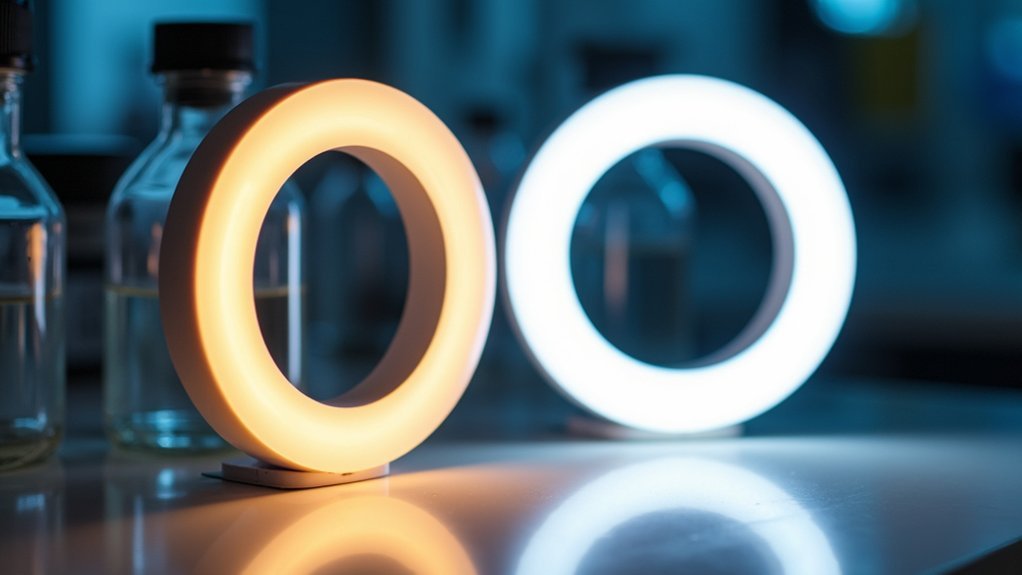
Beyond color temperature considerations, the intensity control of your LED ring light represents another key factor in scientific imaging.
Adjustable intensity ring lights offer precision control from 0-100%, often in 1% increments, allowing you to tailor illumination exactly to your specimen’s requirements.
When choosing between options, consider:
- Detail capture requirements – Adjustable models prevent overexposure of delicate features that fixed intensity lights might wash out.
- Specimen sensitivity – You’ll achieve better results with specimens requiring specific lighting conditions using variable brightness.
- Budget constraints – While fixed intensity lights cost less initially, they’ll limit your imaging capabilities compared to versatile adjustable options.
The investment in an adjustable intensity ring light typically pays dividends in scientific photography quality, especially when shadow-free, precisely calibrated illumination is essential for your research.
Multi-Zone LED Systems for Advanced Specimen Detail
Multi-zone LED systems revolutionize your scientific photography by allowing precise control over shadow elimination through independent adjustment of multiple lighting sections.
You’ll gain the ability to manipulate brightness and angle across different zones, effectively removing unwanted shadows that can obscure critical specimen details.
This advanced technology also enables you to set specific color temperatures for each lighting zone, helping you highlight particular features and achieve ideal contrast for various specimen types.
Shadow Elimination Techniques
When capturing scientific specimens with intricate details, shadows can obscure critical features and compromise research integrity. Multi-zone LED systems offer superior shadow elimination by providing targeted lighting around the specimen, with each zone independently controllable.
- Adjust individual lighting zones to compensate for uneven surfaces and eliminate harsh shadows that might hide important details in recessed areas.
- Fine-tune brightness and color temperature settings to achieve ideal contrast for your specific specimen type—cooler temperatures for structural details and warmer tones for natural tissue coloration.
- Combine different illumination angles from multiple zones to create a thorough lighting environment that reveals surface textures while maintaining the high illuminance levels (30,000+ LUX) necessary for capturing microscopic features.
You’ll find that proper shadow management dramatically improves the scientific value of your photographic documentation.
Zone-Specific Color Control
Scientific photographers can elevate their imaging capabilities through zone-specific color control, a sophisticated feature of advanced LED ring light systems.
With independently controlled lighting zones, you’ll capture intricate specimen details by adjusting brightness and color temperature in specific areas of your viewing field.
These multi-zone Ring Lights produce uniform illumination by eliminating shadows that often obscure crucial details. You can fine-tune the light’s color temperature between 3500K and 7500K, optimizing contrast for different biological structures.
With illuminance reaching up to 35,000 LUX, you’ll reveal microscopic features while maintaining specimen integrity.
This precision control proves indispensable when photographing complex specimens where subtle lighting adjustments can dramatically improve image quality, making multi-zone systems essential tools for serious scientific photography and microscopy applications.
Mounting Solutions for Various Microscope Models
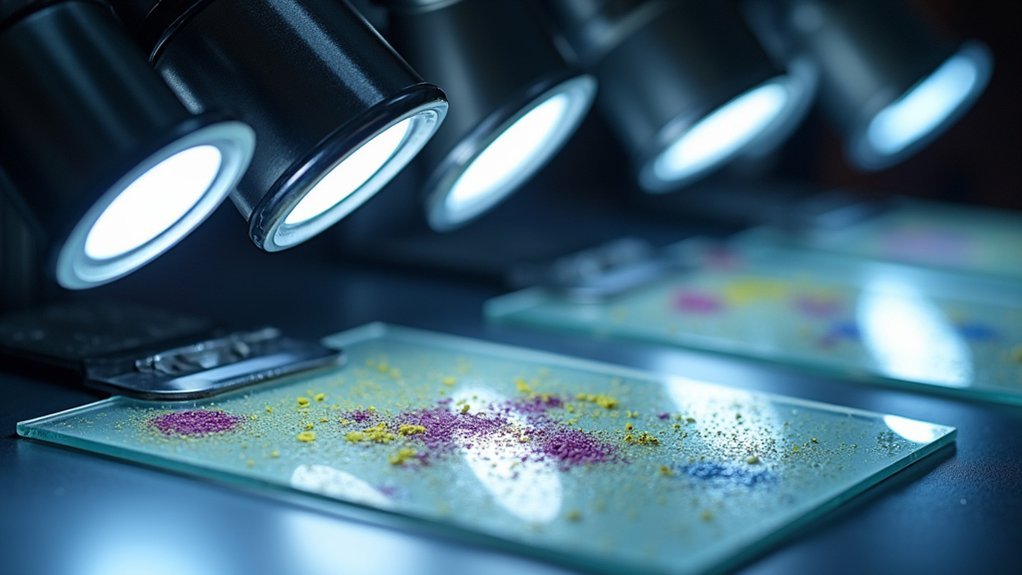
Securing the right mounting attachment for your LED ring light can make all the difference in scientific photography results. When evaluating mounting solutions, first check compatibility between your microscope’s lens diameter and the ring light’s inner dimensions—typically around 2.4 inches for standard models.
Quality mounting options should provide stability without sacrificing flexibility in positioning.
Seek mounts that offer rock-solid stability while maintaining full freedom to position your light precisely where needed.
- Look for adjustable adapters and clamps that offer secure attachment while maintaining unobstructed views of your specimens.
- Consider multi-option mounting systems featuring C-clamps and universal adapters that accommodate various microscope configurations.
- Select mounts with height and angle adjustability to optimize illumination and minimize shadows during imaging sessions.
The best mounting solutions combine sturdy build quality with versatile positioning capabilities, ensuring your ring light remains stable throughout your scientific photography work.
Power Options and Runtime Considerations for Field Research
Field researchers face unique power challenges that go beyond proper mounting solutions. When selecting LED ring lights for fieldwork, you’ll want to prioritize models with USB connectivity for flexible power options and built-in rechargeable batteries for maximum portability.
| Light Type | Runtime | Best Use Case |
|---|---|---|
| USB-Powered | Unlimited (with source) | Lab settings |
| Battery-Powered | 70+ minutes | Field expeditions |
| Hybrid Models | Variable | All-purpose research |
Consider lights with adjustable brightness levels to extend runtime when full illumination isn’t necessary. The Lume Cube Ring Light Pro offers up to 70 minutes of wireless operation at maximum brightness—ideal for thorough specimen documentation. Remember that higher brightness settings require more power, so pack appropriate power banks that deliver sufficient voltage for your specific model when working in remote locations.
Budget-Friendly Ring Lights for Educational Settings
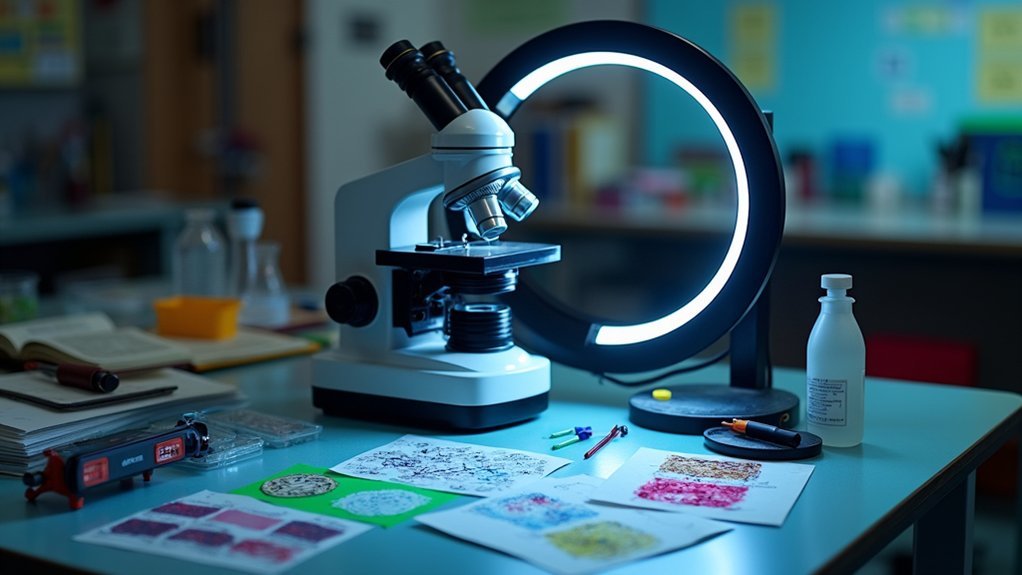
Educational institutions operating with limited budgets need not compromise on quality when selecting ring lights for scientific photography. Several affordable options deliver excellent performance for classroom use while conserving funds.
- The Godox LR120 offers impressive value at just $45, featuring a portable 12-inch design that’s perfect for shared equipment rooms and easy classroom transport.
- For detailed specimen examination, consider the Microscope LED Ring Light with 144 LEDs and 4 Lighting Zones, providing adjustable brightness and independent zone control for shadow-free illumination.
- The Upwtkim 96 LED Ring Light delivers versatility with its adjustable color temperatures (3500K-7500K), helping students capture clear images without eye strain.
Most budget-friendly ring lights are USB-powered with universal voltage compatibility, ensuring they’ll work in any classroom setting.
High-Performance Illumination for Research-Grade Documentation
Three essential qualities distinguish research-grade LED ring lights from their educational counterparts: superior illumination intensity, precise color accuracy, and advanced control features.
When documenting specimens for publication or analysis, you’ll need the robust 35,000 LUX brightness that professional models deliver through high-efficiency LED bulbs.
For accurate specimen representation, select ring lights with CRI ratings above 90, ensuring colors appear as they do naturally. This precision makes them an excellent choice for researchers requiring true-to-life documentation.
The multiple independently controlled lighting zones found in 144-LED models eliminate shadows completely, revealing vital details.
USB-powered options provide versatility across different laboratory settings with universal voltage compatibility, while their cool-running technology protects sensitive specimens during extended observation sessions—a critical consideration for live-specimen research.
Optimal Ring Light Positioning Techniques for Maximum Detail Capture
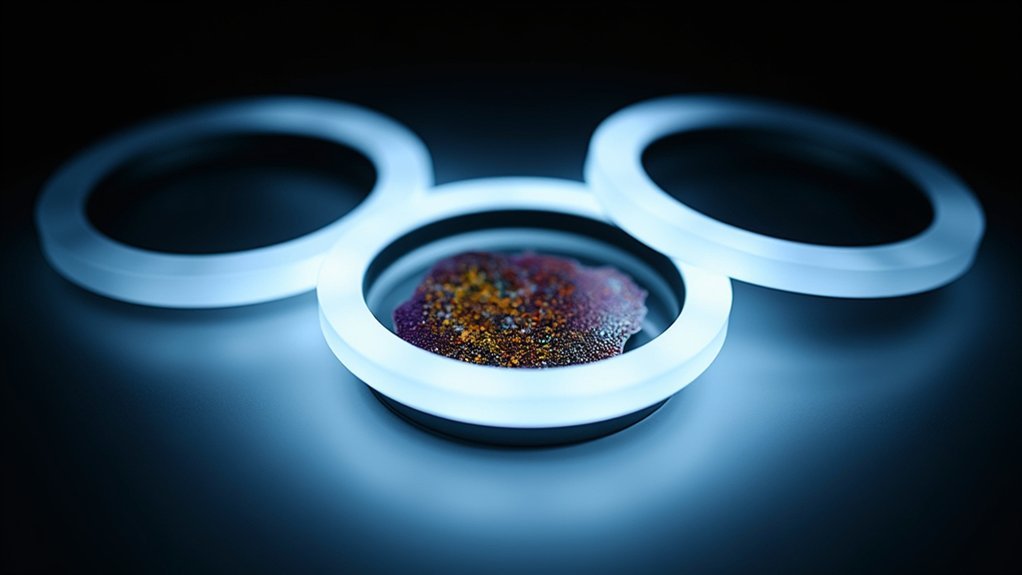
Mastering ring light positioning stands as the cornerstone of capturing scientific specimens with exceptional clarity and detail. Position your ring light 12-24 inches from your subject to achieve ideal illumination without creating unwanted glare or hotspots that can obscure critical features.
For maximum detail capture:
- Angle the light slightly downward to create natural lighting that enhances texture visibility while reducing harsh shadows.
- Adjust brightness levels to guarantee specimens are well-lit without overexposure, preserving subtle details essential for analysis.
- For reflective specimens, tilt the ring light or apply a diffuser to minimize glare.
Don’t hesitate to experiment with color temperature settings between 3500K-7500K to highlight specific features and enhance contrast in your scientific photography.
Frequently Asked Questions
What Is the Best Ring Light for Photography?
For photography, you’ll find the Lume Cube Ring Light Pro ideal with its wireless capability and precise adjustments. It’s excellent for portraits, while Elgato’s 17-inch model offers even illumination for professional shoots.
Do Professional Photographers Use Ring Lights?
Yes, you’ll find that professional photographers regularly use ring lights for portraits, macro work, and beauty shots. They’re valued for their even lighting, flattering catchlights, and ability to minimize shadows on subjects.
How Bright Should a Ring Light Be?
For general photography, you’ll want a ring light with at least 30,000 LUX. Look for one that’s dimmable from 10-100% so you can adjust brightness based on your subject and shooting conditions.
Which Ring Light Do Influencers Use?
Influencers typically use the Elgato Ring Light, Lume Cube Ring Light Pro, or Godox LR120. You’ll want one with high CRI (90+) and precise brightness/color temperature adjustments for creating flawless content on social media.
In Summary
You’ve now explored the essential role LED ring lights play in scientific photography. By choosing the right intensity, color temperature, and positioning, you’ll capture specimen details with remarkable clarity. Whether you’re in a lab, field, or classroom setting, the perfect ring light enhances your documentation capabilities while producing consistent, reliable results for your research and analysis needs.

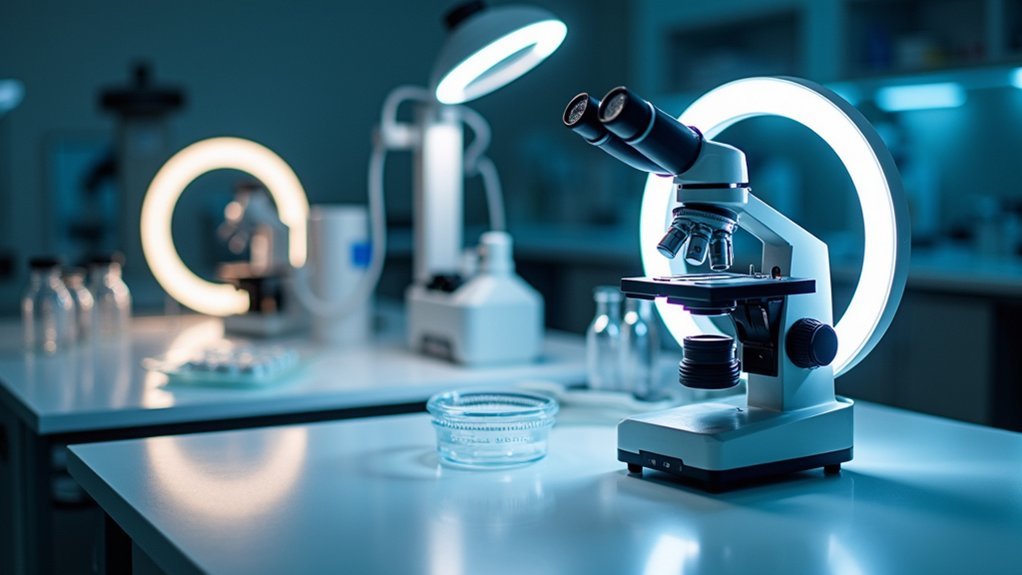



Leave a Reply